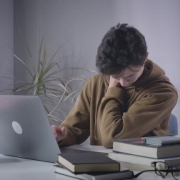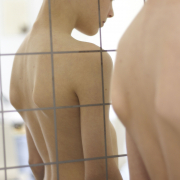More and more students suffer from neck pain: what to do
Almost one in two students regularly suffers from neck pain, but the problem starts much earlier: over 40% of teenagers report having experienced at least one episode of neck pain in the past year.
The prevalence increases with age, affects girls more frequently and intensifies during periods of heavy school workload and intensive use of digital devices.
These figures are clear: neck pain is no longer a condition limited to adults or sedentary workers.
It has become a problem affecting young people and children alike, fuelled by inactivity, hours spent in front of screens and school-related stress.
A silent epidemic
In recent years, especially during the COVID-19 pandemic, we have witnessed a considerable rise in neck pain, particularly among young students. Studying from home, hours spent in front of computers or phones, workload and stress have contributed to this real “silent epidemic.
Neck pain, also known as cervicalgia, concerns the upper part of the spine and can manifest as discomfort, stiffness or more intense pain, sometimes limiting movement and negatively affecting daily life and concentration while studying.
“We increasingly see adolescents complaining of significant cervical symptoms, despite their young age,” comments Martina Poggio, ISICO physiotherapist. “It is a phenomenon that appears early on, sometimes as early as secondary school.”
Poor digital habits and stress
During the pandemic, teaching methods changed drastically, forcing students to spend many hours sitting in front of electronic devices.
The intensive use of smartphones, tablets and computers has often led to poor posture: neck bent forward, curved back, sitting for too long without breaks.
Past events, such as injuries or trauma to the neck and shoulders, make a recurrence of pain more likely. Furthermore, students in the final years of university tend to experience more pain, perhaps due to the heavier study load and accumulated pressure.
Sleepless nights and irregular habits, like staying up late, negatively affect muscle health and contribute to the issue.
“Posture maintained for long periods, especially with the head bent forward, is one of the strongest factors linked to neck pain in young people,” Poggio continues. “Worsening the situation is the lifestyle: inactivity, insufficient sleep, exam stress, and personal pressures create fertile ground for cervical pain.”
Equally important are emotional and psychological factors: anxiety, stress and emotional problems affect not only our mood but also pain perception and muscle condition. Women appear to be affected more often, although the precise reasons for this difference are still not fully understood.
Let’s analyse the causes
Research has identified eleven main factors associated with neck pain, including:
- prolonged poor posture
- improper use of the pillow
- lack of physical activity
- poor quality sleep
- previous trauma
- anxiety and stress
Among these, those who do not exercise enough, risk having weaker and less flexible muscles, less able to properly support the head and spine.
“No single sport is better than another, but it is important that it includes exercises for the upper limbs as well,” Poggio adds, “and that it comprises strengthening exercises, not just stretching and lengthening, because the neck needs to be prepared to cope with daily strains.”
Furthermore, incorrect pillow use is particularly significant: a pillow that is too high or too low, too soft or too firm can compromise neck position during sleep and cause pain on waking.
Curiously, neck pain affects girls more than boys. Emotional aspects, pain perception and hormonal factors may play a role.
Prevention: what can we do
Fortunately, many causes can be prevented with simple care:
- choose a suitable pillow that keeps the neck in a natural position during rest
- maintain good posture: sit with a straight back, keep the screen at eye level, avoid crossing legs or slouching in the chair
- take frequent breaks from PC or phone screens to relax the muscles
- practise regular physical exercise
- get enough sleep
- manage stress with relaxation techniques (yoga, breathing exercises)
“The problem is not so much a relaxed posture for a short time, but spending hours bent forward. So besides paying attention to how you sit, it is important to get up frequently, even just for short breaks, which greatly helps manage neck strain,” explains Poggio. “Accumulated stress tends to tighten muscles, increasing pain and stiffness. Practising relaxing activities such as yoga or breathing techniques can help keep body and mind in balance.”
In conclusion
Neck pain is an increasingly common complaint among young students, but understanding its causes and taking early action can prevent worsening and improve quality of life.
Small daily attentions can prevent this troublesome problem, keeping the back and neck healthy and ready to support all the challenges of study and life.
Bibliography
Gao Y, Chen Z, Chen S, Wang S, Lin J. Risk factors for neck pain in college students: a systematic review and meta-analysis. BMC Public Health. 2023 Aug 8;23(1):1502. doi: 10.1186/s12889-023-16212-7.
Geldhof E, De Clercq L, et al. The Prevalence of Neck Pain and Its Associated Factors in Children and Adolescents: A Systematic Review and Meta-Analysis. J Orthop Sports Phys Ther. 2023.







